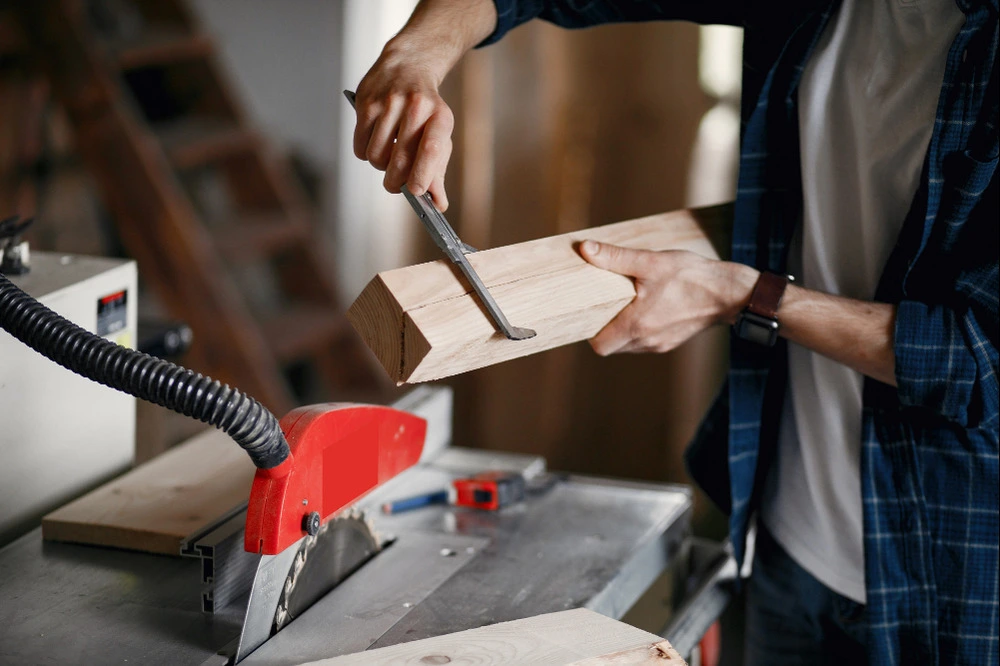Last Updated on August 29, 2024 by hamid_firuzi
Woodworking is an art that requires skill, creativity, and, most importantly, the right tools. Whether you’re a beginner or a seasoned pro, having the right hand tools is essential to creating precise and beautiful pieces. This guide will walk you through the 40 essential hand tools every woodworker should have in their workshop. From measuring tools to cutting and finishing equipment, this list ensures you are fully equipped to tackle any woodworking project.
Measuring and Marking Tools
- Tape Measure
A tape measure is a fundamental tool for any woodworker. It helps you take accurate measurements, ensuring that your cuts are precise.
- Combination Square
A combination square is versatile, helping you measure angles, check for squareness, and mark straight lines.
- Marking Gauge
A marking gauge is essential for drawing parallel lines along the wood’s edge, ensuring accurate and repeatable results.
- Caliper
A caliper allows you to measure the internal and external dimensions of your workpieces with extreme precision.
- Sliding Bevel
A sliding bevel is adjustable, making it perfect for transferring angles from one piece of wood to another.
- Spirit Level
A spirit level ensures your workpieces are perfectly horizontal or vertical, crucial for cabinetry and furniture making.
- Ruler
A simple yet indispensable tool, a ruler helps you measure lengths and mark straight lines with accuracy.
- Try Square
A try square is vital for checking the squareness of edges and ensuring that your cuts are at the correct angles.
- Compass
A compass is great for marking out circles and arcs, especially useful for more intricate woodworking designs.
- Protractor
A protractor helps you measure and mark out angles, which is essential for tasks like cutting joints or molding.
Cutting Tools(SAW)
- Hand Saw
A hand saw is one of the most basic yet versatile tools, perfect for making straight cuts in wood.
- Coping Saw
A coping saw allows for intricate cuts and is ideal for creating curves and detailed shapes.
- Japanese Saw
A Japanese saw has a thin blade, making it ideal for fine cuts and precision work.
- Rip Saw
A rip saw is designed for cutting along the grain of the wood, making it an essential tool for reducing larger pieces.
- Crosscut Saw
A crosscut saw is perfect for cutting across the grain, giving you clean and precise cuts every time.
- Backsaw
A backsaw has a reinforced spine, making it ideal for accurate and controlled cuts, especially in joinery.
- Chisel Set
A chisel set is indispensable for fine woodworking, allowing you to carve out joints and remove small amounts of material.
- Coping Saw
A coping saw is excellent for cutting intricate shapes and interior cutouts, essential for detailed work.
- Hacksaw
A hacksaw is versatile, used for cutting through metal, plastic, and even wood with small, fine teeth.
- Fret Saw
A fret saw is similar to a coping saw but with a deeper frame, making it perfect for intricate work with tight curves.
Shaping and Planing Tools
- Block Plane
A block plane is perfect for smoothing edges, chamfering, and removing small amounts of wood to refine a piece.
- Jack Plane
A jack plane is versatile, used for smoothing surfaces, removing high spots, and preparing wood for further finishing.
- Spokeshave
A spokeshave is ideal for shaping and smoothing curved surfaces, such as chair legs or handles.
- Rasp
A rasp is used for rough shaping of wood, particularly in areas where a plane cannot reach.
- File
A file helps in the fine shaping and smoothing of wood, essential for creating smooth surfaces and intricate details.
- Router Plane
A router plane is used to clean up grooves, dadoes, and tenons, ensuring a flat and even surface.
- Card Scraper
A card scraper is a simple tool used to smooth and finish wood surfaces, removing small amounts of material.
- Cabinet Scraper
A cabinet scraper is similar to a card scraper but larger, used for smoothing large surfaces.
- Spindle Sander
A spindle sander is ideal for smoothing curved and contoured surfaces, particularly useful in shaping furniture.
- Drawknife
A drawknife is used for rough shaping of wood, particularly in making round or irregular shapes.

Assembly and Finishing Tools
- Clamps
Clamps are essential for holding pieces together while glue dries or when making precise cuts.
- Mallet
A mallet is used to strike chisels or drive wooden parts together without damaging the wood.
- Screwdrivers
A set of screwdrivers is vital for assembling furniture and driving screws into wood.
- Hand Drill
A hand drill is used to create holes in wood, allowing for the insertion of screws or dowels.
- Nail Set
A nail set helps you drive nail heads below the surface of the wood, making them easier to conceal.
- Awl
An awl is used to mark points for drilling or to start screws, ensuring they go in straight.
- Workbench
A workbench is not a hand tool but an essential part of your workshop, providing a sturdy surface for all your work.
- Sandpaper
Sandpaper is essential for finishing wood, helping to smooth surfaces and prepare them for staining or painting.
- Vise
A vise is used to hold workpieces securely, allowing you to work on them with both hands free.
- Glue
Wood glue is essential for joining pieces of wood together, ensuring a strong and lasting bond.
Conclusion
Having the right tools is crucial for any woodworker, whether you’re just starting or have years of experience. This ultimate list of 40 essential hand tools covers everything you need to equip your workshop for success. From measuring and marking tools to cutting, shaping, and finishing, each tool serves a specific purpose, helping you achieve precision and quality in your projects. Investing in these tools will not only improve your craftsmanship but also make your woodworking experience more enjoyable and efficient.

